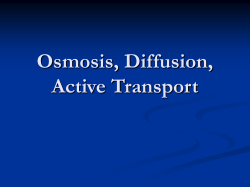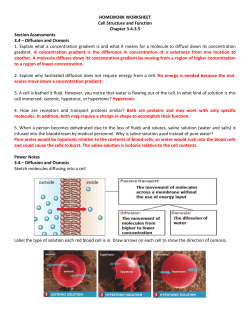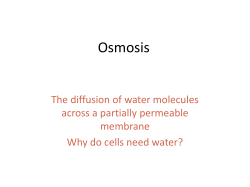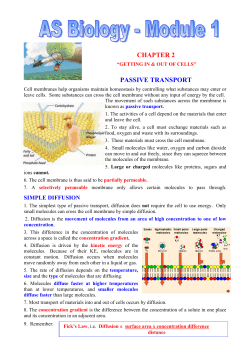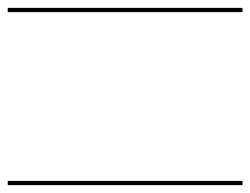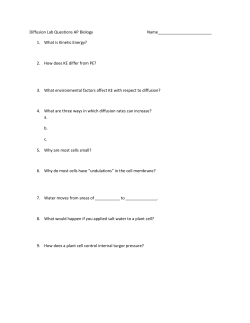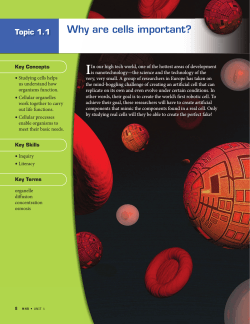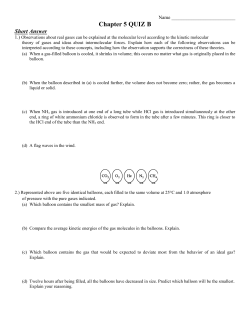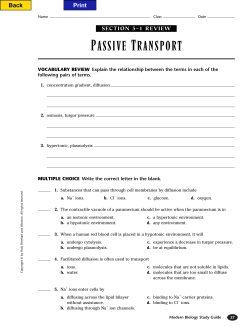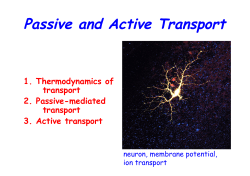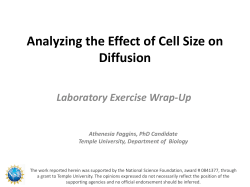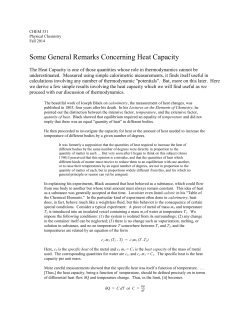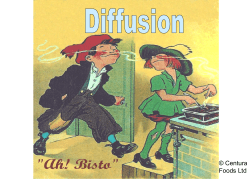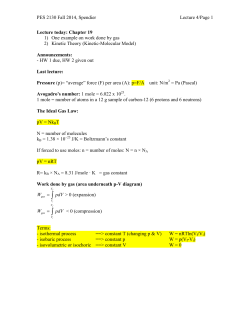
Chapter 3.4 - Membrane Structure and Function Why?
Chapter 3.4 - Membrane Structure and Function How do substances move in and out of cells? Why? An advertisement for sports drinks, such as Gatorade, PowerAde, and Vitaminwater, etc. seem to be everywhere. All of these drinks are supposed to help your body recover and replenish lost electrolytes, fluids, and vitamins after exercise. But how do the essential molecules contained in these drinks get into your cells quickly to help you recover after exercise? Model 1 – Simple Diffusion 1. How many different types of molecules are shown in Model 1? Two 2. Count and record the number of triangles and circles found on each side of the membrane. Triangles — 14 on left, none on right; Triangles — 14 on left, none on right 3. Which shape is larger? Triangle 4. Describe the direction of the movement of the molecules in Model 1? Triangle 5. Which molecules are able to pass through the semi-permeable membrane? Justify your answer. The dots, because they are small and can fit though the gaps, and because they are shown as equally distributed on both sides of the membrane Model 2 – The Selectively Permeable Cell Membrane 7. What two major types of biological molecules compose the majority of the cell membrane in Model 2? Phospholipids and proteins 8. How many different protein molecules are found in Model 2? Four—two types of surface proteins and two types of membrane -spanning proteins 9. What is the difference between the position of the surface proteins and the membrane-spanning proteins? Surface proteins do not reach across the membrane, while membrane spanning proteins do 10. When a carbohydrate chain is attached to a protein, what is the structure called? Glycoprotein 11. When a carbohydrate is attached to a phospholipid, what is the structure called? Glycolipid 12. What types of molecules are shown moving across the membrane? Small polar and nonpolar molecules 13. Where exactly in the membrane do these molecules pass through? Between the phospholipids 14. How does the concentration of the small molecules inside the cell compare to that outside the cell? More small molecules are outside the cell compared to inside, so the concentration is higher outside compared to inside 15. Because particles move randomly, molecules tend to move across the membrane in both directions. Does the model indicate that the molecules are moving in equal amounts in both directions? Justify your answer using complete sentences. No, more molecules are moving into the cell compared to moving out of the cell. The arrows show the movement - Read This! When there is a difference in concentration of a particular particle on either side of a membrane, a concentration gradient exists. Particles move along the concentration gradient from high to low concentration until a state of equilibrium is reached. At that point, there is no more net movement in one direction, although the particles continue to move randomly across the membrane, often called dynamic equilibrium. The net movement of particles along the concentration gradient is called diffusion. 16. Look back at Models 1 and 2. Which particles are moving by diffusion across the membranes shown? Dots in Model 1 and small polar and nonpolar molecules (also represented by dots) in Model 2 17. Using all the information from the previous models and questions circle the correct response to correctly fill in each blank. a. Diffusion is the net movement of molecules from an area of (low/high) concentration to an area of (low/high) concentration. b. The molecules will continue to move along this (semi-permeable membrane/concentration gradient) until they reach (diffusion/equilibrium). c. Once equilibrium is reached, molecules will continue to move across a membrane (randomly/in one direction). Model 3 – Facilitated Diffusion 18. Which part of the cell membrane is shown in more detail in Model 3? Membrane-spanning proteins (These are often referred to as channel proteins later in the activity.) 19. What is the gap between the proteins called? Gated channel 20. Looking at the diagram on the left, will the glucose molecules be able to pass through the protein channel? Explain your answer in complete sentences? No, the glucose is too big to pass through the channel in the diagram on the left 21. Explain in detail what happened that allowed the glucose molecules to pass through. A hormone molecule attached to the top of the protein and caused it to change shape; the channel became larger and allowed the glucose to pass through Read This! Some molecules, such as glucose, use gated channels as shown in Model 3; however, not all channels are gated. Some channels remain permanently open and are used to transport ions and water across the cell membrane. 22. Discuss with your group why the type of protein channel in Model 3 is called a gated channel. Write your group’s responses below. The channel acts like a gate; when the hormone molecule binds with the protein, it acts like a key that opens the locked gate and allows molecules through. 23. To facilitate means to help. Explain why this type of diffusion is called facilitated diffusion. The glucose needs the help of the hormone and the protein channel in order to cross the membrane, but, the process is still diffusion—moving from high concentration of glucose to low concentration. 24. The “tails” of phospholipids are nonpolar; therefore, they do not readily interact with charged particles such as ions. How can this explain why facilitated diffusion is necessary for the transport of ions such as Na+ and K+ across the cell membrane? In other words, why would these ions not cross by simple diffusion? Because they are charged particles, the nonpolar phospholipid tails would provide a barrier and prevent them from crossing the membrane without a channel Model 4 – Active Transport 25. Which part of the cell membrane is shown in more detail in Model 4? Look back at Model 2 if needed. Membrane-spanning (channel) proteins 26. What shape represents the substance being transported across the membrane in Model 4? Diamond 27. List two binding sites found on the protein. ATP- and ion-binding sites 28. In which direction is the transported substance moving—from an area of high concentration to low or from an area of low concentration to high? Support your answer. The transported substance is moving from an area of low concentration to high concentration. More particles are seen in the area toward which the arrow is pointing 29. Is the substance being moved along (down) a concentration gradient? Justify your answer. The transported substance is moving from an area of low concentration to high concentration. More particles are seen in the area toward which the arrow is pointing 30. ATP is a type of molecule that can provide energy for biological processes. Explain how the energy is being used in Model 4. Energy is used to change the shape of the protein (open the channel). 31. What happens to the ATP after it binds to the protein? It changes to ADP 32. The type of transport shown in Model 4 is called active transport, while diffusion and facilitated diffusion are called passive transport. Given the direction of the concentration gradient in active and passive transport examples, explain why active transport requires energy input by the cell. Active transport moves molecules against (up) a concentration gradient, whereas in passive transport molecules move down a concentration gradient. To move molecules against a gradient requires energy. 33. With your group, complete the table below to show the difference between active and passive transport. Passive Transport Active Transport Requires energy input by the cell Moves molecules against (up) a concentration gradient X Always involves channel (membrane-spanning)proteins X Molecules pass between the phospholipids Moves large molecules Moves small nonpolar and polar molecules Facilitated Diffusion X X X Molecules move along (down) a concentration gradient Moves ions like Na+ and K+ Diffusion X X X (though students might not know this from the activity) X X X X EXTRACREDIT 35. Given the information in the graph, which type of cell transport would be best to move substances into or out of the cell quickly? Active transport 36. Which type of transport would be the best if the cell needs to respond to a sudden concentration gradient difference? Diffusion—the rate increases as the concentration difference increases 37. Why would the line representing facilitated diffusion level off as the concentration gets higher, while the line representing diffusion continues to go up at a steady rate? Facilitated diffusion relies on proteins—the number of proteins will limit how fast the substance can be moved. Even if the concentration continues to increase, the number of protein channels will limit the rate of facilitated diffusion 38. Why does active transport, on the same graph, start off with such a high initial rate compared to diffusion and facilitated diffusion? Active transport does not depend on a concentration gradient, only a supply of energy.
© Copyright 2025
